by pmdavis | Nov 25, 2013
 Thanksgiving is a time of family traditions, reflection and thankfulness! Remember to include children in the planning and preparation. In 4-H, we stress learn by doing and want to encourage you to consider that motto. Children love being included that inspires their creativity, imagination and sense of belonging. Being involved teaches life skills, such as measuring, meal preparation, teamwork, design and relationship building.
Thanksgiving is a time of family traditions, reflection and thankfulness! Remember to include children in the planning and preparation. In 4-H, we stress learn by doing and want to encourage you to consider that motto. Children love being included that inspires their creativity, imagination and sense of belonging. Being involved teaches life skills, such as measuring, meal preparation, teamwork, design and relationship building.
Some ways to involve children are very simple! Have them help shop or find bargains with a Thanksgiving Scavenger Hunt. Give each child a list of grocery products to find. They will have fun locating items at the store or finding the best buys in advertisements. Older kids can clip coupons.
Make simple inexpensive decorations. Create turkey hand or leaf wall hangings, wreaths, a tree of thanks, clay or play dough holiday ornaments, centerpieces, placemats, name cards, napkin rings. Napkin rings can be made out of cut paper towel rolls or construction paper glued in a circle and decorated with artwork, fabric, leaves or even feathers. Guests will admire these items while enjoying the meal.
To help the day go smoothly, consider your needs and home size. For example, if you have a small kitchen let them help you prepare items ahead of time for the meal i.e cranberry salad. Consider having older youth select a recipe to be the lead chef. Doing a trial run prior to the holiday meal. Kids can easily help: wash fruits and vegetables, snap green beans, crack eggs, stir cake batter, roll out pie crusts, mash potatoes, sprinkling marshmallows or put relish items on a tray.
Let kids set the table. Make the task simple by using printable table-setting cheat sheet, showing where items should be placed. Have kids count out the number of place-mats, name cards and napkin rings needed.
Other traditions to consider include:
- 1. Create a turkey of thanks. Have children cut paper feathers and place them at each place setting. When everyone sits down to eat, have them write one thing they are thankful for. Create a paper turkey centerpiece by passing a paper bag and glue stick letting each person glue on their feather telling why they are thankful.
- 2. Make a family trivia game. Have children ask each person to write down trivia questions about events that happened during the year, or family history. Collect the questions and give out small prizes for each correct answer.
- 3. Play the A to Z family gratitude game. Have everyone sit together and each person says what they’re grateful for, according the letter of the alphabet the player is up to.
- 4. Read a book about Thanksgiving to help children learn the meaning of Thanksgiving.
- 5. Help someone less fortunate or in poor health by serving meals, raking leaves, taking a plate of food.
Sounds simple, and in all reality it is. Adults give guidance to children helping them identify and feel good the positive things in their lives. The trick is to relax, plan and enjoy the holiday together. One web page that gives lots ideas for holiday decorations the family can do together http://aboutfamilycrafts.com/30-turkey-crafts-for-kids/. All Extension programs are open to all persons regardless of race, color, age, sex, handicap or national origin.
by Melanie Taylor | Nov 22, 2013
As the autumn temperatures continue to fall, and we fill our days and evenings with more time outside, many of us yearn to enjoy the natural beauties of the environment without the humidity, extreme heat, and summer insects. During the activity portion of each 4-H Club meeting is a great time to explore and create using the natural resources around us. The purpose of these nature projects is to develop an appreciation for our environment. Conservation can only truly take place once we have recognized the natural beauty and wonder that surrounds us. These projects are generally easy to do, and kids can work on them together if they wish. And, there are more challenging projects for the older 4-H youth.
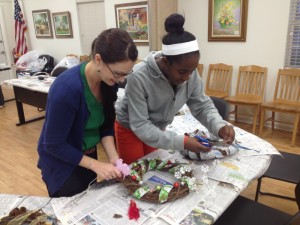
Gulf County adult 4-H Club leader assists a 4-Her on the finishing
touches of her grapevine wreath.
The Gulf County 4-H Craft Club members recently made their own grapevine wreaths and decorated them in their own creative ways.
Materials:
- vine
- pruners
- ribbon and a variety of decorating supplies (pinecones, twigs, leaves, glitter, character cut-outs, floral decorations, miniature birds, etc.)
- hot glue and glue gun
- pipe cleaners (to make a hook for hanging)
Directions:
1. Be sure to begin by finding a large location that can get dirty. The vines drop lots of debris. Find an abundance of firm, but bendable grape vines, gathering and untangling the vine pieces. When they have been tamed into a bundle (thickness is based on individual preference) that is manageable, form the vine into a circular shape on a large surface. Using a few thick strands of vine, begin to wind around the bundle, tucking the end of the vine in. (Note: if natural vines are not available, premade wreaths may be purchased at any craft store at a minimal cost.)
2. Continue to wind and secure the entire wreath. When the end meets the beginning, knit the vine ends together and continue to wind the outer vines to secure, overlapping the starting point. Tuck in any loose ends.
3. Set the wreath somewhere to dry and take shape. Preferably in a warm, sunny location. They will dry much faster this way. (If the kids will be making their own vine wreaths, and not using a pre-purchased one from a craft store, the wreath will need to be made days ahead of the decorating to give it time to dry properly.)
4. Now, it’s time to decorate. Let the kids be imaginative and create their own unique wreath to match their likes and personality. They can experiment by placing the items in different locations on the wreath. Once their decorating decisions are made use the hot glue to secure the items, ribbons, etc.
5. Do not forget to form a loop with a short piece of pipe cleaner to make a hook on the back of the wreath to hang it from.
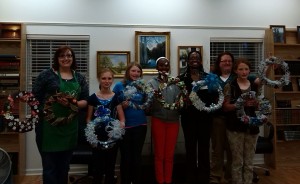
4-H Club members showcase their grapevine wreaths
Now, the wreaths can be taken home and enjoyed by all. Be sure to remember that time spent in nature is calming and refreshing to the human mind. So, as the weather becomes more tolerable here in Florida be sure to take time for yourself and to show youth the importance of natural exploration and creativity.
by jgl1 | Nov 8, 2013
John G. Lilly
jgl@ufl.edu
Jefferson County Extension Director/4-H Agent
Young people in 4-H are committed to improving their communities. Dr. Richard Lerner, and the team at the Institute for Applied Research in Youth Development at Tufts University highlights a notable trend. 4-H youth are three times more likely to actively contribute to their communities when compared with youth who do not participate in 4-H. (more…)
by Julie Pigott Dillard | Nov 8, 2013
All of you 4-H members with fall herb gardens: Would you be willing to sacrifice your apiaceous herbs to the Black Swallowtail Caterpillar?
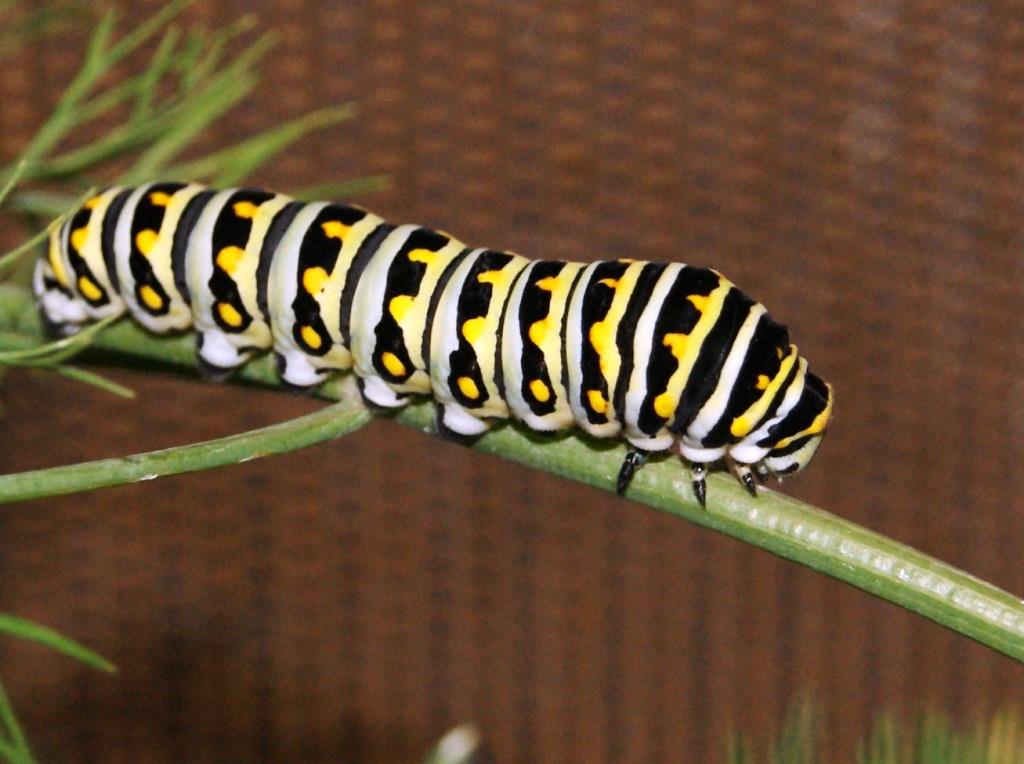
Busily devouring dill and fennel, the lime green, black striped caterpillars in the UF IFAS Extension Washington County Office have quickly become a popular attraction. It is fortunate that the South’s climate is warm enough to allow for three generations of this species every year.
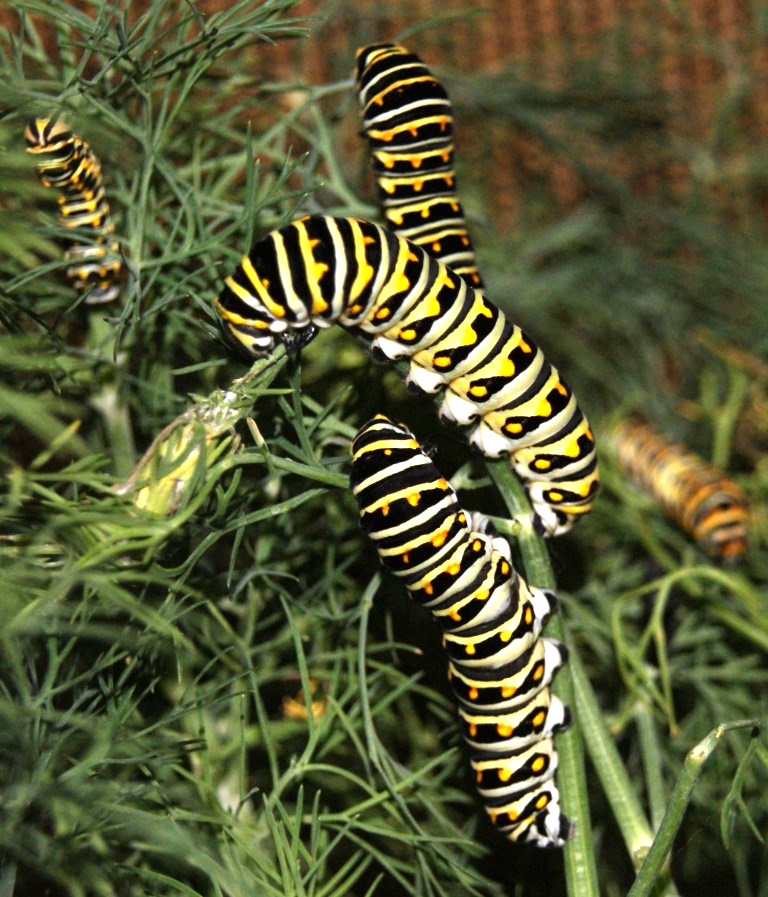
Soon, the caterpillars of the Black Swallowtail (Papilio polyxenes asterius ) butterfly species will continue their pupae stage by forming a chrysalis and emerging as one of Florida’s most recognized swallowtail butterflies.
The chrysalis is formed by two glands located inside the caterpillar that secrete silk. The silk threads stick together and harden when exposed to fresh air. The hard, protective coating is usually camouflaged from predators and blends in with the environment. Inside the chrysalis, the process of metamorphosis continues as the adult structure forms while the juvenile structure breaks down. The insects are very inactive during this time as they grow and change. This stage can last from two weeks to an entire season in temperate climates and tropical dry seasons. When hormones indicate it’s ready, the butterfly emerges by splitting the chrysalis open either biting its way out or using spit to soften the ends.
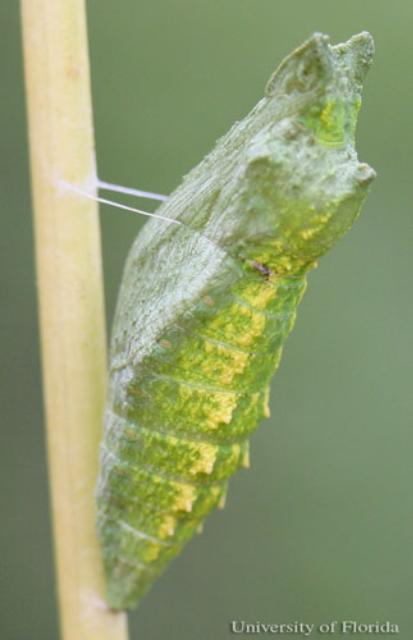
The Black swallowtail has quite a heavy appetite for such a small creature. They eat a variety of plants in the carrot family (Apiaceae) such as dill, fennel, parsley, celery, and carrot leaf. In addition to these cultivated species, they will feast on mock bishopweed, roughfruit scaleseed, spotted water hemlock, water cowbane, and wedgeleaf eryngo. They have also been known to enjoy Common Rue (Ruta graveolens L.).
They exhibit several interesting behaviors throughout their life cycle. For example, when they feel threatened the Black Swallowtail will exhibit yellow antennae-like structures called osmeterium. These flare out and emit a foul odor, like rotten cheese, if one’s finger gets too close.
Even though they are voracious plant eaters and honorable defenders of their territory, butterflies play a vital role in agriculture by pollinating crops and flowers. They’re an indicator of a healthy ecosystem; an abundance and diversity of butterfly species illustrate the overall health of an area. With their acute sensitivity to contaminants and toxins, butterfly populations will not be found in polluted areas. Recognized for their beauty, butterfly watching has also become a popular hobby and pastime.
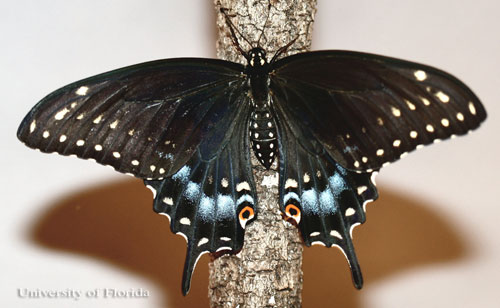
- Photo courtesy of Donald Hall, University of Florida.
It’s never too early to think about planning a butterfly garden. For more information on creating a backyard butterfly habitat, download this 4-H fact sheet for kids and parents. For more information on this specific butterfly, visit the UF IFAS EDIS website for a publication on the Eastern Black Swallwtail.
Additional Content by:
Matthew Orwat, Extension Faculty I, Horticulture, UF IFAS Extension Washington County
 Thanksgiving is a time of family traditions, reflection and thankfulness! Remember to include children in the planning and preparation. In 4-H, we stress learn by doing and want to encourage you to consider that motto. Children love being included that inspires their creativity, imagination and sense of belonging. Being involved teaches life skills, such as measuring, meal preparation, teamwork, design and relationship building.
Thanksgiving is a time of family traditions, reflection and thankfulness! Remember to include children in the planning and preparation. In 4-H, we stress learn by doing and want to encourage you to consider that motto. Children love being included that inspires their creativity, imagination and sense of belonging. Being involved teaches life skills, such as measuring, meal preparation, teamwork, design and relationship building. 





